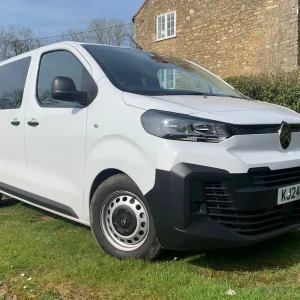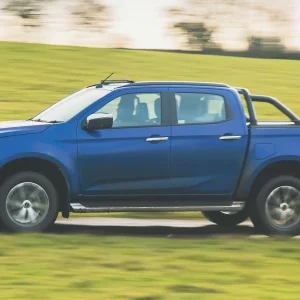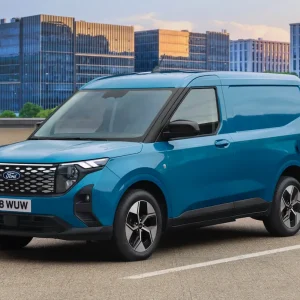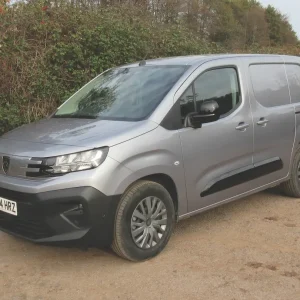Oxford’s decision to introduce a zero-emission zone embracing several streets in its centre is a harbinger of what is bound to come. The council has made no secret of its intention to expand the area, and towns and cities across the UK are sure to copy what the city of dreaming spires is doing over the next few years.
That means urban delivery will be going battery-electric, like it or not. Businesses will need to start thinking seriously about acquiring vans that will comply with this requirement.
The good news is that there is no lack of choice. All the leading light commercial manufacturers and many of the minor players now have electric models available, with global automotive behemoth Stellantis well to the fore.
A series of mergers and takeovers means that Stellantis now owns Peugeot, Citroën, Vauxhall and Fiat Professional. One consequence is that many of the light commercials marketed by these brands are virtually identical to each other, bar their badges and some styling tweaks in order to leverage economies of scale.
Furthermore, Stellantis has developed a close working relationship with Toyota. As a consequence Toyota’s Proace City is pretty much the same as Peugeot’s Partner, Vauxhall’s Combo, and Citroën’s Berlingo; and all four are available in battery-electric as well as diesel guise.
Citroën e-Berlingo van fanciers can choose from one power pack and two lengths with a single roof height, and two different trim levels. A crew van is available on the longer platform.
As good environmentalists we opted to sample the long-wheelbase e-Berlingo Van Enterprise Pro XL. Here’s how we fared.

Load bay
Access to the 3.8m3 load area is by means of a sliding door on each side of the body and through asymmetric twin rear doors. The narrower of the two is on the offside.
They can be swung through 90°, and through 180° if you unlatch the easy-to-release stays.
Six floor-mounted tie-down rings are fitted plus one at waist height on each side of the cargo box.
Two more rings are attached to the full-height steel bulkhead, which separates the cab from the cargo area. It features a hatch at floor level that allows extra-long items to be pushed under the passenger seat.
The floor is protected from scratches and scrapes by a tailored hard plastic cover (an option), while plastic panels afford some protection to the sides to half their height. Deep side rubbing strips are fitted externally to help protect the body from minor damage.
An optional on-board weighing system was fitted to our demonstrator with buttons positioned just inside the back doors on the nearside. It should help ensure operators do not overload the vehicle, which is something we can only applaud.
A 12V power socket was positioned just inside the back doors on the offside; handy if your job involves the use of power tools.

Interior and equipment
An 8in colour touchscreen sits on the dashboard and controls the DAB radio and the optional satellite navigation, and features a USB point. Bluetooth compatibility is included in the deal.
Our van was covered by a six-month Free2Move telematics subscription, which addresses everything from its location to alerts if any faults arise. The optional satnav can be specified with three-year subscriptions which covers real-time traffic updates and the presence of speed cameras.
Handy features include air-conditioning, a 12V socket close to the floor plus a 240V power point in the passenger foot-well, electric, power-folding, exterior mirrors, electric windows, reversing sensors and front fog lights. A driver’s airbag is fitted (you pay extra for the curtain, front lateral and passenger airbags that protected us) as was in our case, a reversing camera (an option, with front sensors), and cruise control with a programmable speed-limiter. Like the traction control system, the latter can be switched off.
All the doors lock automatically at speeds above 7mph and the vehicle is protected by a Thatcham Category 1 alarm. The headlights illuminate automatically at dusk.
Storage facilities in the three-seater cab include bins in each of the doors with mouldings to hold a big bottle of water, a full-width shelf above the windscreen and a lidded, but not lockable, glove-box with a shelf beneath it. Three cup-holders are provided, and you can fold down the back of the middle seat and turn it into an impromptu desk.
That’s about all the middle seat is good for given the severely-restricted amount of legroom it offers. Featuring lumbar adjustment, the driver’s seat is height-adjustable, as is the (optionally leather-trimmed) steering wheel which plays host to the radio’s remote controls.
Onboard safety systems include ABS, Electronic Stability Control, Hill Start Assist, Electronic Brakeforce Distribution and Electronic Brake Assist. Disc brakes are fitted all round, and an AVAS (Acoustic Vehicle Alerting System) is installed which generates a noise to warn pedestrians and cyclists of e-Berlingo’s presence when it is being driven at low speeds around town.
Our demonstrator was additionally graced by an optional safety pack which includes Active Lane Departure Warning, Speed Limit Recognition, Active Safety Brake and Distance Alert System. Let’s see some of these items made standard.
MacPherson strut-type suspension is installed at the front and a torsion beam set-up is deployed at the back.
Decorated with plastic trims, our e-Berlingo’s 16in steel wheels were shod with Michelin Primacy 3 215/65 R16 tyres.
An on-board monitoring system warns the driver if they start to lose pressure. Happily, a full-size spare wheel is provided rather than a sometimes-worse-than-useless inflator/sealer.

Powertrain
Power comes courtesy of a 50kWh lithium-ion battery recharged through a combined CCS/Type 2 port and our e-Berlingo was equipped with a 7.4kW on-board charger. A 6m-long Mode 3 charging cable is provided with Type 2 connectors for charging from wall boxes and public charging points.
The van’s 100kW (136hp) electric motor generates 260Nm of torque. With an electric motor it is, of course, available immediately.
Driving
No need to worry about changing gear once the electronic parking brake
is released.
The motor drives the front wheels through what is in effect a step-less single-speed automatic transmission.
A switch gives you the simple choice of reverse, neutral or drive; so take your pick.
A button next to it lets you increase the level of regeneration so you pump some charge back into the battery every time you lift your foot off the accelerator pedal and the van decelerates.
It slows the van noticeably without the need to resort to the brake pedal – good news for brake component life – in effect functioning as a retarder.
While it is not as nimble through bends as its short-wheelbase counterpart, the long-wheelbase e-Berlingo rides better and is much less of a puddle-jumper.
Because electric motors are far quieter than diesels, all the other sources of noise on a van – squeaks from the suspension, rattles from the base of the bulkhead – can become more obvious; and irritating.
Not an issue with e-Berlingo A good standard of build quality meant there was not a groan or creak to be heard.
As a consequence we were able to sit back and enjoy the van’s performance.
When we flicked a switch that gave us the Power option the result was a firm, smooth push between the shoulder blades as e-Berlingo surged ahead.
On the negative side your range goes down at the same time. A dashboard display tells you how much is left.
Choose the Eco setting instead and your range improves, but the van’s ability to accelerate briskly and maintain motorway speeds is alas throttled. We had expected the cab’s heating system to be turned down at the same time to reduce the power drain, but happily this did not happen.
Having sampled both options we stuck with Normal for most of our test; the default setting and a satisfactory compromise.
Citroën cites a 171-mile range between recharges according to WLTP (Worldwide Harmonised Light Vehicle Test Procedure) figures. We got close to 140 miles before we felt the need to find a charging point.

Operating
A three-year/60,000-mile warranty protects e-Berlingo, with the battery separately covered by an eight-year/100,000-mile warranty to reassure customers who may be worried about high replacement costs. Service intervals are set at two years/25,000 miles.
Citroën quotes a 31-hour charging time if you plug e-Berlingo into an 8amp domestic electric plug socket, although in our experience it does not take anywhere like as long. A display in the cab allows you to set the time when you want charging to start.
Plug your vehicle into a 32amp wallbox and it will take seven-and-a-half hours says the manufacturer. Use a rapid 100kW DC charger then you can restore your battery to 80% of its capacity in just half an hour, it adds.
Citroen e-Berlingo Van Enterprise Pro XL 50kWh
Price (ex VAT, inc. PiVG) £27,955
Price range (ex VAT, inc. PiVG) £26,755–£29,105
Gross payload 751kg
Load length 2,167mm
Load width (min/max) 1,299mm/1,527mm
Load bay height 1,200mm
Load volume 3.8m3
Loading height 548mm
Rear door aperture 1241mm x 1196mm
Side door aperture 675mm x 1072mm
Gross vehicle weight 2400kg
Braked trailer towing weight 750kg
Residual value 27.5%
Cost per mile 45.4p
Electric motor 100kW (136hp)
Torque 260Nm
Gearbox 1sp
Range (WLTP) 171mls
Battery 50kWh
Warranty 3yrs/60,000mls (battery 8yrs/100,000mls)
Service intervals 2yrs/25,000mls
Insurance group TBA
Price as tested £32,905
(Running costs after 48 months/20,000 miles p.a – source – KWIKcarcost)
Options
Citroen Connect navigation package £450
Rear-view camera with parking sensors £350
Leather-trimmed steering wheel £100
Curtain, front lateral and passenger airbags £490
Safety pack £760
Load floor protection £60
Overload indicator £240
Rivals
Nissan eNV200
Price (ex. VAT) £26,305–£35,035
Load volume 4.2m3
Gross payload 705kg
Electric motor 80kW
Verdict: Nissan is continuing to market the eNV200 even though it is no longer as youthful as it once was, and despite the fact that the diesel model is now no longer with us. With an impressive alleged range of up to 187mls and a respectably-sized load area, it nevertheless remains in contention.
Renault Kangoo Van E-Tech
Price (ex. VAT) £26,000–£28,100
Load volume 3–4m3
Gross payload 605-625kg
Electric motor 44kW
Verdict: The data quoted here alludes to the current and on-the-verge-of-being superseded Kangoo. Its successor arrives here this summer, and should be worth the wait. Snatching the What Van? Compact Van of the Year Award for 2022, it offers a decent payload, plenty of cargo space and an upgraded interior.
Renault Zoe Van E-Tech
Price (ex. VAT) £26,450–£28,575
Load volume 1m3
Gross payload 435-457kg
Electric motor 80kW
Verdict: We were enormously impressed by this pocket cargo shifter when we road-tested it in 2021. Admittedly it has not got the largest load area in the world or the most-generous payload capability, but at up to 245 miles its claimed range deserves to be applauded. All-in-all it makes for an ideal zero-emission urban runabout.
The Final Verdict
Design 8/10 – A well-thought-out package likely to appeal to those engaged in last-mile delivery
Cabin 5/10 – Why try to stuff three seats into a cabin that is only wide enough for two?
Ride 8/10 – Smoother than the ride on offer from its short-wheelbase counterpart
Refinement 9/10 – Whisper-quiet, with no squeaks or groans thanks to decent build quality
Load area 9/10 – Plenty of anchorage points and easy access. Overload indicator worth investing in
Handling/performance 7/10 – Less nimble than the short wheel-base on bends but straight-line ability not an issue
Powertrain 8/10 – Smart package giving range and an easy recharge. Use the regeneration capability
Standard equipment 7/10 – Most of what you need is there, but some optional safety devices should be standard
Operating costs 8/10 – Day-to-day running expenditure looks good when considering diesel costs
What Van? subjective rating 8/10 – Well worth a look if you operate locally and want to go the zero-emission route
Overall Rating = 77/100





